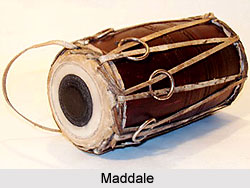 Maddale is percussion instrument from the Indian state of Karnataka. It is the primary rhythmic accompaniment in a Yakshagana ensemble along with Chande. Maddle is actually used in Yakshagana and also looks similar to the Indian wind instrument of Mridangam but it is also markedly different in structure, acoustics playing techniques and the system of rhythm (Yakshagana Tala). Maddale also uses the Yakshagana Tala system. Traditionally the variety of Maddale is shorter and high pitched. Maddale is available in more than three diverse variations.
Maddale is percussion instrument from the Indian state of Karnataka. It is the primary rhythmic accompaniment in a Yakshagana ensemble along with Chande. Maddle is actually used in Yakshagana and also looks similar to the Indian wind instrument of Mridangam but it is also markedly different in structure, acoustics playing techniques and the system of rhythm (Yakshagana Tala). Maddale also uses the Yakshagana Tala system. Traditionally the variety of Maddale is shorter and high pitched. Maddale is available in more than three diverse variations.
History of Maddale
History of Maddale actually belongs to Mridangam family of drums and hence shares the history of similar drums. Its drum head is similar to Tabla and the drum itself is similar to Pakhavaj. As a matter of fact, one of the names of Pakhavaj is also Mardal which is very similar to the name Maddale (Madala). Unlike Pakhavaj the bass drum head is not bigger and the technique of playing is also different.
Thus it is also likely that Maddale is the variation of Mridangam and Pakhavaj. Conventional variety of Maddale was high pitched and shorter. Over the years, the Maddale evolved to be made of variety of woods and for lower octave and today its body is constructed from wood of jackfruit tree among other woods like Kakke, Baine and Hunaalu. The use of this instrument has evolved with the development of Yakshagana and Yakshaganic fingering and hand techniques have been developed. Interesting use of palm produces a sound that is somewhat a mixture of Pakhawaj and Mridangam.
Physical Components of Maddale
This instrument - Maddale, is actually a double sized drum whose body is usually made using a hallowed piece of jackfruit wood which is about half and inch thick. The apertures or two mouths of the drums are actually covered with the skins of goat leather and also laced to each other with the straps of leather around the circumference of drum. These straps are then put into a state of high tension to stretch out the circular membranes on either sides of the hull, allowing them to resonate when it is struck. These two membranes are actually similar in width to allow for the production of brass from one and treble sound from the other. The drum head are known as "muchchige".
The brass drum is head and is also called the "eda muchchige" and the drum head is called "Bala Muchchige". The right drum head is same as Tabla drum head. When it is properly stuck, then it produces a high pitched sound. The left of the drum head also produces lower pitched bass sound. The right drum head has a kind of circular disk in the centre and is also known as "Karne" causing the drum to make Harmonic tones. The left drum is smeared with the paste made from rice and ash known as "Bona", before performance to dampen the tone and to produce bass sound.
Methods Of Use
Maddale is tuned to the tonic of the Yakshagana singer before performance. A wooden peg is also sometimes used to tighten the strap of leather.




















